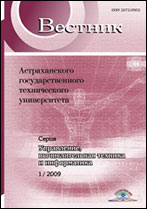|
|
Vestnik of Astrakhan State Technical University. Series: Management, Computer Sciences and Informatics, 2016, Number 3, Pages 67–77
(Mi vagtu443)
|
 |
|
 |
TELECOMMUNICATION SYSTEMS AND NETWORK TECHNOLOGIES
Energy calculation of hydroacoustic communication lines
B. I. Filippov
Novosibirsk State Technical University
Abstract:
Energy calculation of hydroacoustic communication channel is divided into a number of interrelated steps: selection of the operating frequency of the link; choice of hydroacoustic antennas; determination of acoustic signal strength. When choosing the operating frequency of hydroacoustic communication systems, the frequency dependence of parameters of hydroacoustic signal should be taken into account. The operating frequency should be chosen from the two following conditions: obtaining the minimum emitted power and ensuring maximum throughput ceteris paribus. An important parameter, that characterizes the efficiency of the antenna in the emission mode, is a specific power, which is equal to the ratio of active acoustic power, which is emitted by the transmitter to the area of its fluctuating surface. Features of antenna's directivities will largely determine the energy potential of the communication link and, therefore, the communication range with tight restrictions on energy consumption from independent power supply on the bottom station. In its turn, the power consumption of the equipment with limited power consumption of the power source will determine working duration of the autonomous bottom stations without lifting for a replacement of power sources (batteries, batteries). The higher the aimed properties of the transmitting and receiving antennas, the better energy potential of link. But with improved of antenna's directed properties, the width of the directional characteristics will decrease, and therefore, the angle of spatial viewing will also decrease, that will lead to decrease in communication zone on the water surface and corresponding decrease in the communication range. In this work the mass-produced hydroacoustic antennas 1D1 and SKOL-2000P were compared. The calculations showed that for the same quality of the transmission power of the digital information supplied to the antenna 1D1 should be in 75 times more than the power supplied to the antenna SKOL-2000P. This suggests the feasibility of using the antennas SKOL-2000P in the hydroacoustic communication systems.
Keywords:
hydroacoustic channel, hydroacoustic antenna, operating channel frequency, acoustic radiation power.
Received: 18.09.2015
Revised: 09.12.2015
Citation:
B. I. Filippov, “Energy calculation of hydroacoustic communication lines”, Vestn. Astrakhan State Technical Univ. Ser. Management, Computer Sciences and Informatics, 2016, no. 3, 67–77
Linking options:
https://www.mathnet.ru/eng/vagtu443 https://www.mathnet.ru/eng/vagtu/y2016/i3/p67
|

|




 Contact us:
Contact us: Terms of Use
Terms of Use
 Registration to the website
Registration to the website Logotypes
Logotypes








 Citation in format
Citation in format 